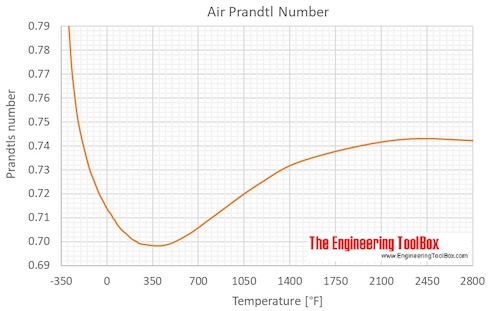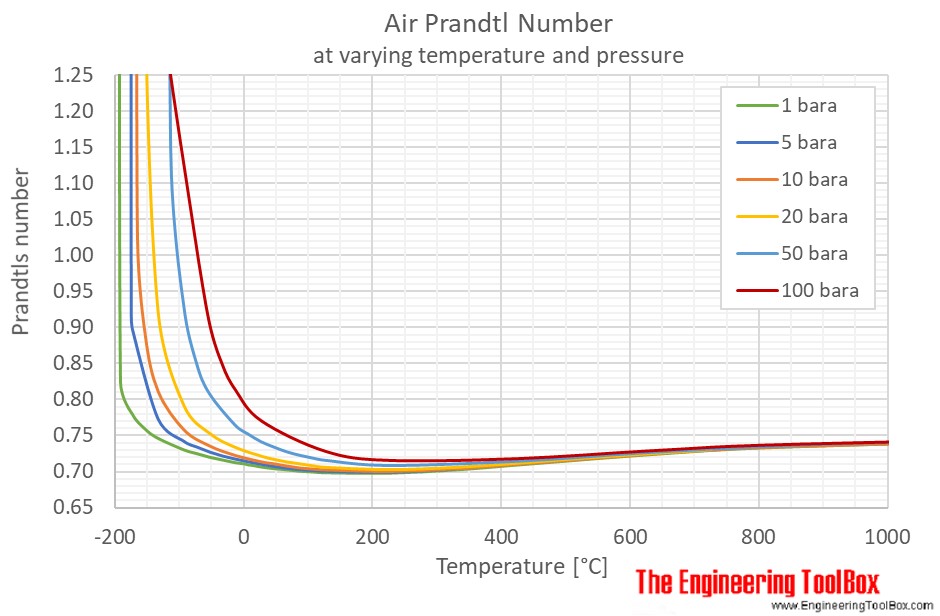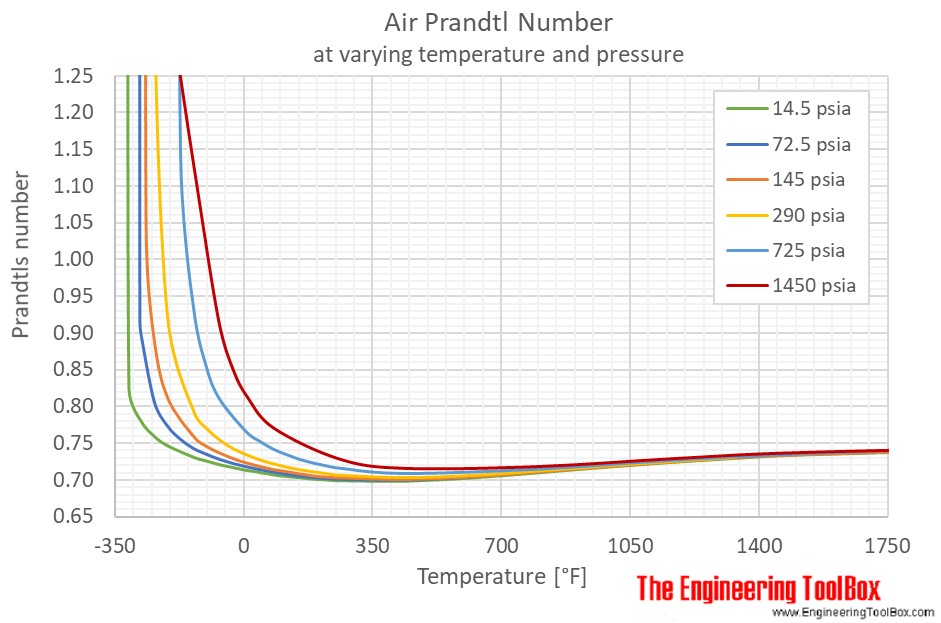Air - Prandtl Number (original) (raw)
The Prandtl Number - Pr - is a dimensionless number approximating the ratio of momentum diffusivity (kinematic viscosity) to thermal diffusivity - and is often used in heat transfer and free and forced convection calculations.
The Prandtl number can for calculations be expressed as
Pr = μ cp / k (1)
where
μ = absolute or dynamic viscosity (kg/(m s), (lbm/(ft h))
cp = specific heat (J/(kg K)), (Btu/lbmoF)
k = thermal conductivity (W/(m K)), (Btu/(h ft2oF/ft))
Below, Prandtl numbers for air at varying temperatures and pressures are given in figures and tables.
See also other properties of Air at varying temperature and pressure: Density and specific weight at varying temperature, Density at varying pressure, Diffusion Coefficients for Gases in Air, Specific heat at varying temperature and Specific heat at varying pressure, Thermal Conductivity, Thermal Diffusivity, Properties at gas-liquid equilibrium conditions and Air thermophysical properties at standard conditions and Composition and molecular weight,
as well as Prandtl number of Ammonia, Carbon dioxide, Methane, Nitrogen, Propane and Water .
Air Prandtl number at 1 bara pressure, temperature given as °C or °F:


Air Prandtl number at varying temperatures and constant pressures, SI and Imperial units:


Air Prandtl number at 1 bara pressure, temperature given as °C or °F:
Air - Prandtl Number at 1 bara Pressure
| Temperature | Pr | Temperature | Pr |
|---|---|---|---|
| (°C) | (-) | (°F) | (-) |
| -100 | 0.734 | -150 | 0.733 |
| -50 | 0.720 | -50 | 0.719 |
| 0 | 0.711 | 0 | 0.714 |
| 25 | 0.707 | 60 | 0.709 |
| 50 | 0.705 | 75 | 0.708 |
| 100 | 0.701 | 100 | 0.706 |
| 150 | 0.699 | 200 | 0.701 |
| 200 | 0.698 | 300 | 0.699 |
| 250 | 0.699 | 400 | 0.698 |
| 300 | 0.702 | 500 | 0.700 |
Air Prandtl number at given temperatures and 1, 5 10 and 20 bara pressure:
Air - Prandtl Number
| Temperature | Prandtl number at given pressures | |||||
|---|---|---|---|---|---|---|
| (K) | (°C) | (°F) | 1 bara, 14.5 psia | 5 bara, 72.5 psia | 10 bara, 145 psia | 20 bara, 725 psia |
| 60 | -213.2 | -351.7 | 4.138 | 4.153 | 4.170 | 4.187 |
| 80 | -193.2 | -315.7 | 1.7 | 2.252 | 2.259 | 2.269 |
| 100 | -173.2 | -279.7 | 0.780 | 0.898 | 1.783 | 1.770 |
| 120 | -153.2 | -243.7 | 0.759 | 0.806 | 0.890 | 1.360 |
| 140 | -133.2 | -207.7 | 0.747 | 0.773 | 0.812 | 0.923 |
| 180 | -93.2 | -135.7 | 0.731 | 0.743 | 0.759 | 0.792 |
| 200 | -73.2 | -99.7 | 0.726 | 0.735 | 0.745 | 0.769 |
| 220 | -53.2 | -63.7 | 0.721 | 0.728 | 0.736 | 0.754 |
| 240 | -33.2 | -27.7 | 0.717 | 0.722 | 0.729 | 0.742 |
| 260 | -13.2 | 8.3 | 0.713 | 0.718 | 0.723 | 0.734 |
| 273 | 0.0 | 32.0 | 0.711 | 0.715 | 0.720 | 0.729 |
| 280 | 6.9 | 44.3 | 0.710 | 0.714 | 0.718 | 0.727 |
| 289 | 15.6 | 60.0 | 0.709 | 0.713 | 0.716 | 0.723 |
| 300 | 26.9 | 80.3 | 0.707 | 0.711 | 0.714 | 0.722 |
| 320 | 46.9 | 116.3 | 0.705 | 0.708 | 0.711 | 0.717 |
| 340 | 66.9 | 152.3 | 0.703 | 0.705 | 0.708 | 0.714 |
| 360 | 86.9 | 188.3 | 0.701 | 0.703 | 0.706 | 0.711 |
| 380 | 106.9 | 224.3 | 0.700 | 0.702 | 0.704 | 0.709 |
| 400 | 126.9 | 260.3 | 0.699 | 0.701 | 0.703 | 0.706 |
| 500 | 226.9 | 440.3 | 0.698 | 0.700 | 0.701 | 0.703 |
| 600 | 326.9 | 620.3 | 0.703 | 0.704 | 0.704 | 0.706 |
| 700 | 426.9 | 800.3 | 0.710 | 0.710 | 0.711 | 0.712 |
| 800 | 526.9 | 980.3 | 0.717 | 0.718 | 0.718 | 0.719 |
| 900 | 626.9 | 1160.3 | 0.724 | 0.725 | 0.725 | 0.725 |
| 1000 | 726.9 | 1340.3 | 0.730 | 0.730 | 0.730 | 0.731 |
| 1100 | 826.9 | 1520.3 | 0.734 | 0.735 | ||
| 1500 | 1226.9 | 2240.3 | 0.743 | 0.743 | ||
| 1900 | 1626.9 | 2960.3 | 0.742 | 0.742 |
Related Documents
Air Properties - Density, Viscosity, Heat Capacity, Thermal Conductivity, and more
Thermal properties of air, including density, viscosity, thermal conductivity, specific heat and more at different temperatures and pressures. Comprehensive reference with formulas, tables, and charts to support engineering calculations.
Moist Air - Properties
Psychrometric table with humid air properties like saturation pressure, specific volume, enthalpy and entropy.
Solubility of Air in Water
The amount of air that can be dissolved in water decreases with temperature and increases with pressure.


